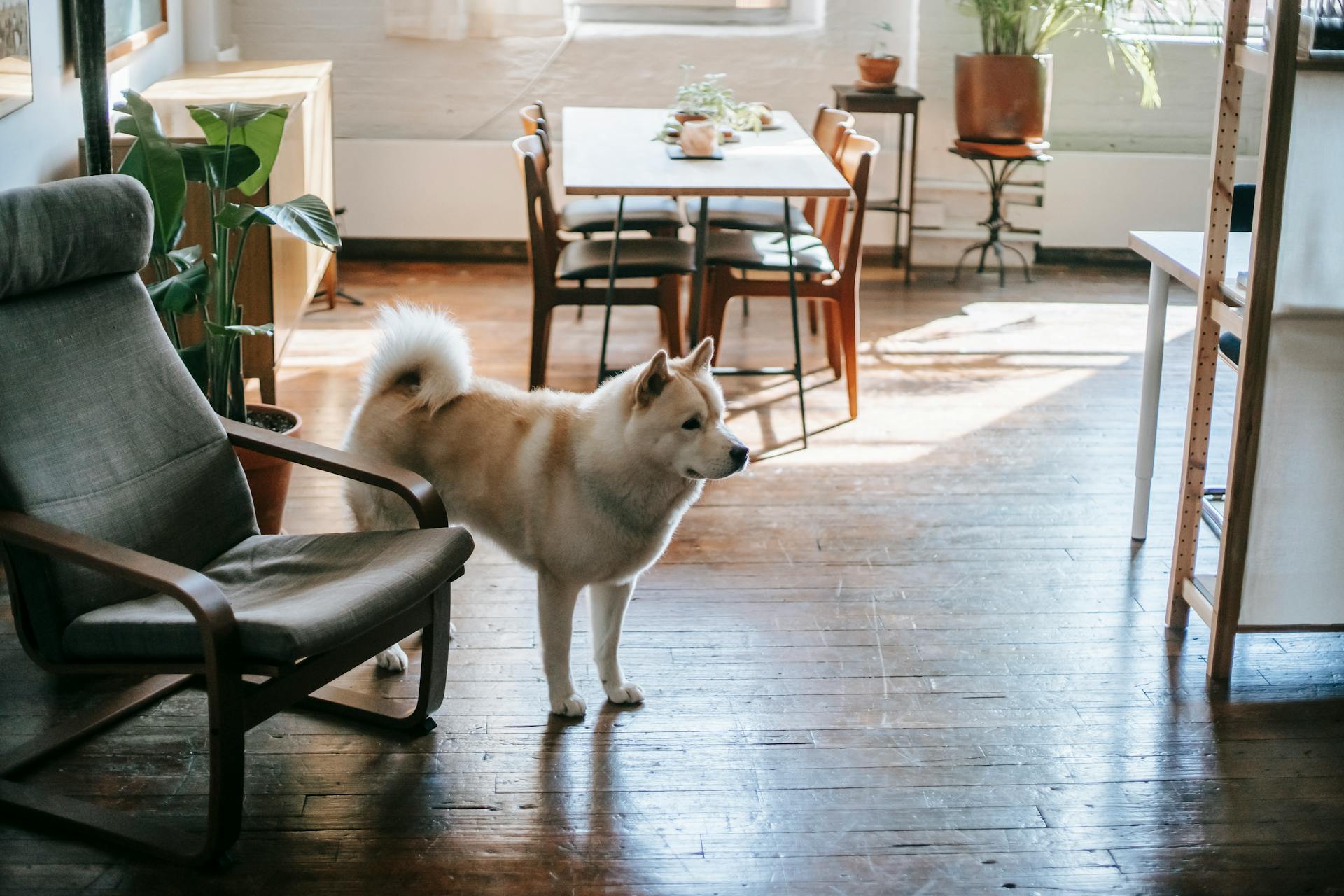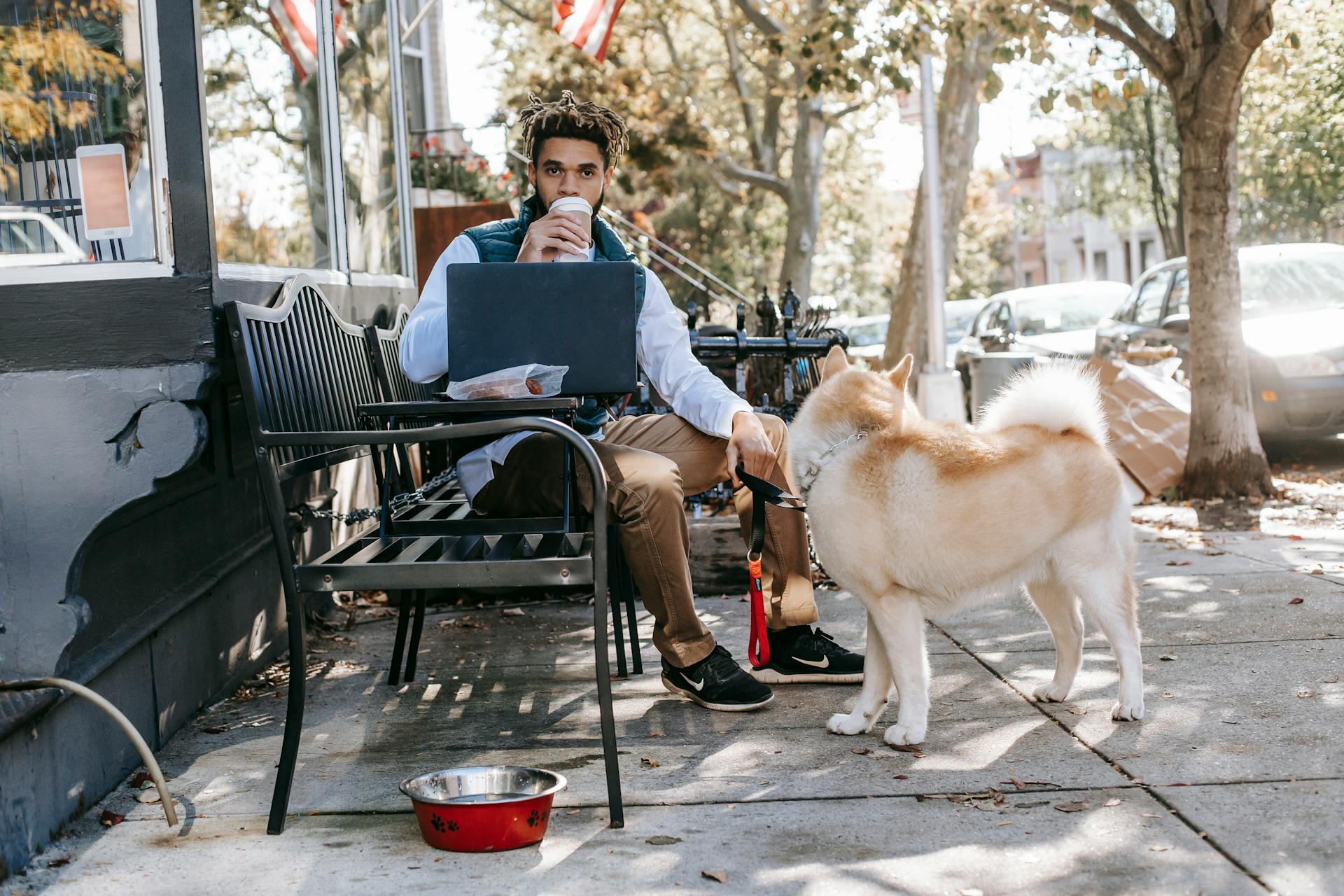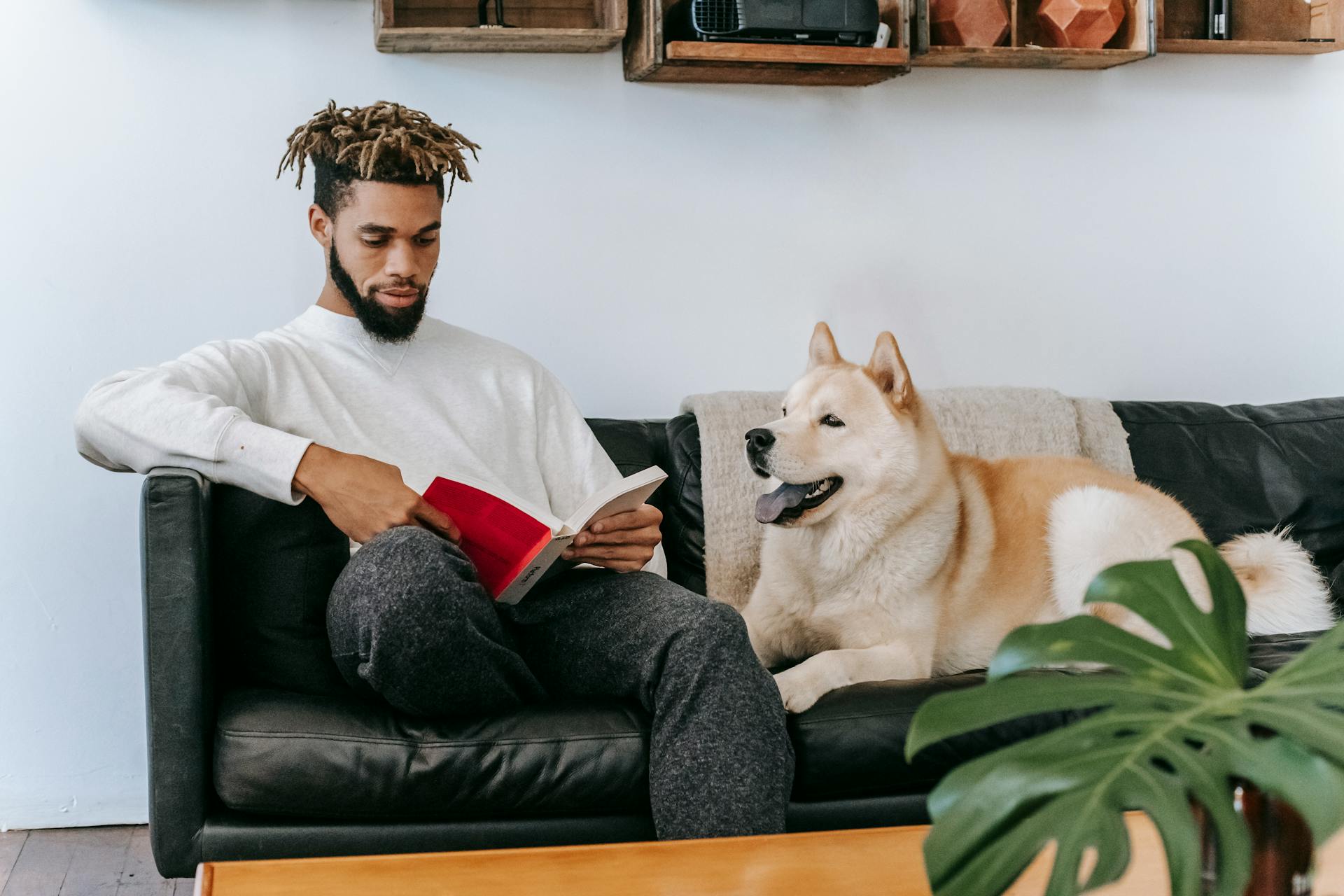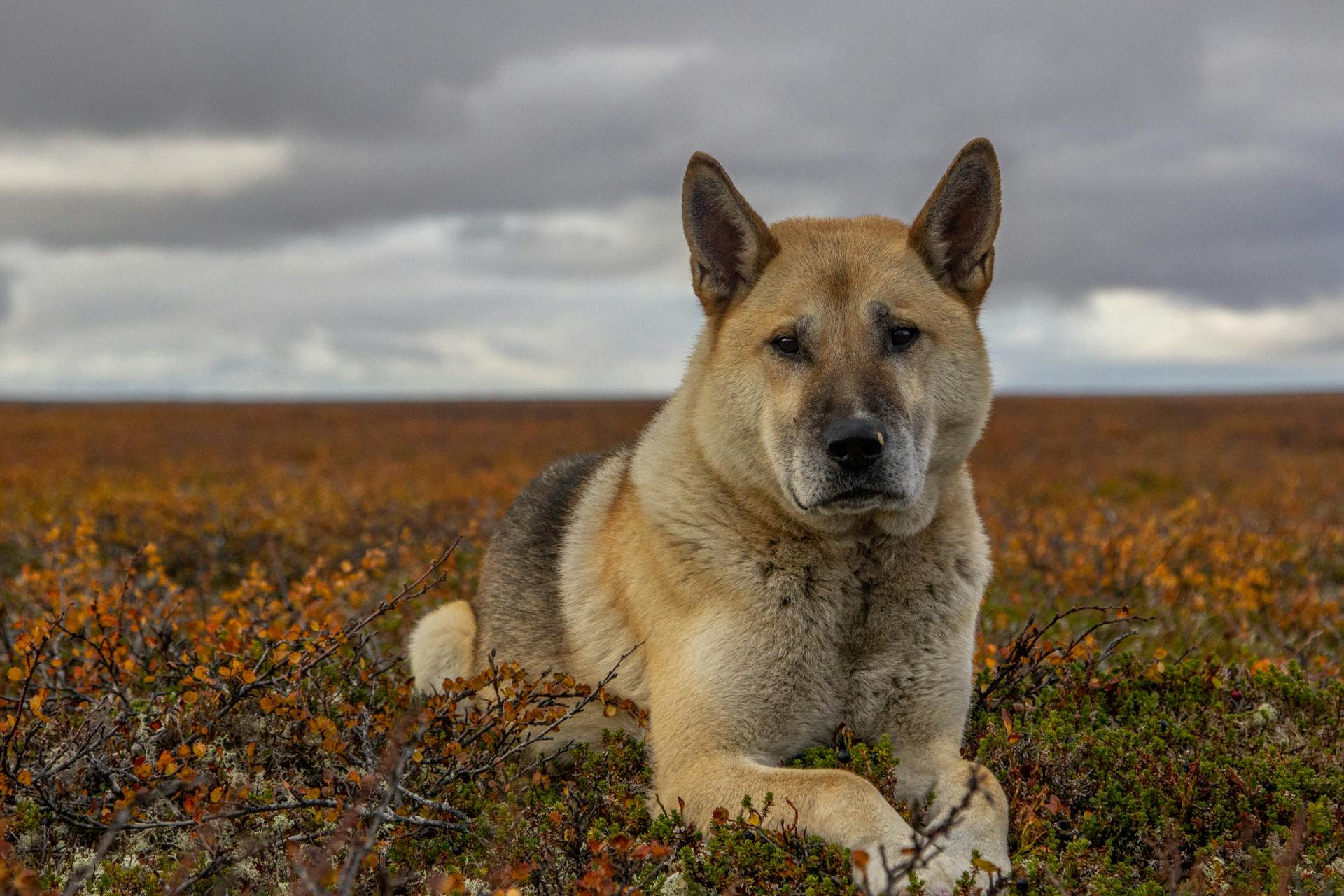
The American Akita is a loyal and loving breed that makes a great companion for many families.
This breed originated from the Japanese Akita, which was brought to America in the 1920s.
American Akitas are known for their thick double coats, which require regular grooming to prevent matting and tangling.
They are generally quiet dogs, but may bark to alert their owners to potential threats.
The American Akita is a large breed, with males weighing between 100-130 pounds and standing 26-28 inches tall at the shoulder.
If this caught your attention, see: Tall Bulldog Breed
Breed Characteristics
The American Akita is a powerful Spitz breed with a massive build and a sturdy stance. Their skin is pliant, but not loose, and they have solid muscular bodies covered with a double coat that's short and lush.
Their hair is dense and fine underneath, while their overlying hair is straight, coarse, and harsh. This double coat helps them withstand harsh weather conditions. Their hair becomes slightly longer towards the lower end of their neck, stomach, and hindquarters.
Their cat-like feet have hard pads, plenty of fur, and are knuckled up, which helps them walk on snow by distributing their weight evenly. Their toes are also webbed, making them well-suited for snowy terrains.
Here are some key physical characteristics of the American Akita:
They have a slightly tapered muzzle and thin black lips, giving them a distinctive appearance.
Highlights
The American Akita is a majestic breed that exudes a powerful and regal presence. Their large head, small triangular eyes, and confident stance make them a sight to behold.
One of the standout characteristics of the American Akita is their natural deterrent effect. They're not afraid to stand their ground and protect their family, which can be a reassuring presence for owners.
Their unwavering loyalty is renowned, and they form deep bonds with their owners. They're a loving and devoted protector, always looking out for their family's well-being.
American Akitas are courageous guardians, willing to face challenges head-on to keep their loved ones safe. They're not easily intimidated and will stand up for what's right.
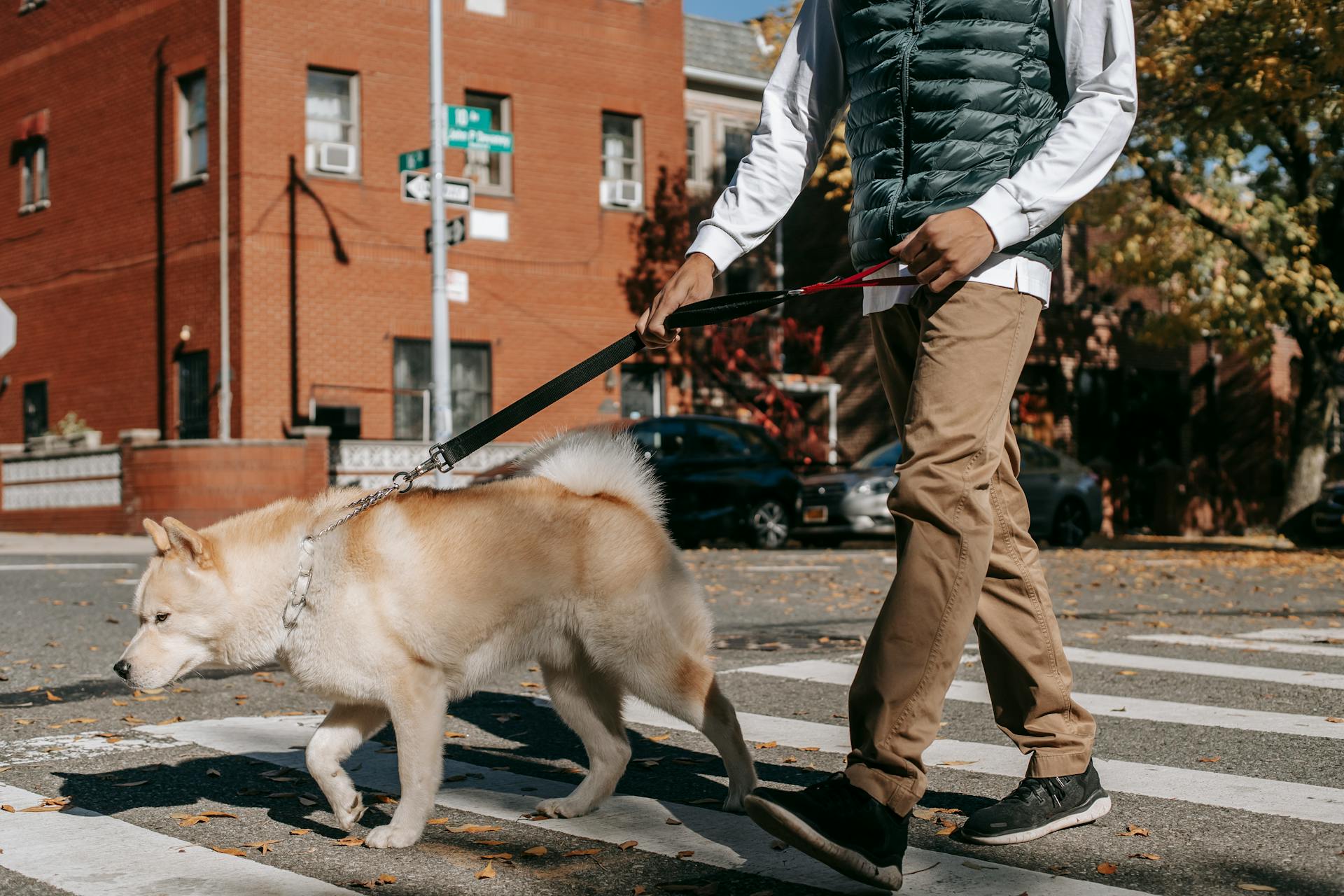
Despite their tough exterior, American Akitas are also vocal and expressive, communicating through grunts, moans, and charming "talking" traits. They're intelligent and communicative, often engaging in mouthing as a form of expression.
Here are some key characteristics of the American Akita:
- Majestic appearance
- Natural deterrent
- Unwavering loyalty
- Courageous guardian
- Vocal and expressive
- Intelligent and communicative
Size
The American Akita is a large and powerful dog breed, with males typically standing between 26 to 28 inches at the shoulder.
Males can weigh anywhere from 100 to 130 pounds, making them a sturdy presence.
Females, on the other hand, are slightly smaller, measuring between 24 to 26 inches at the shoulder.
They typically weigh between 70 to 100 pounds, a significant size difference from their male counterparts.
Most American Akitas reach their full size and weight by the age of 2, embodying their full, dignified stature and solid build.
For more insights, see: How Tall Do Akitas Get
Breed Traits
The American Akita is a powerful breed with a majestic presence. They have a large head, small triangular eyes, and a confident stance that exudes a regal and intimidating aura.
Their physical characteristics are well-suited for work, with a massive build and sturdy stance. Their skin is pliant, but not loose, and they have a solid muscular body covered with a double coat that's short and lush.
One of the distinctive features of the American Akita is their unique paw structure. Their cat-like feet have hard pads, plenty of fur, and are knuckled up, which helps them walk on snow by distributing their weight evenly.
Here are some key physical characteristics of the American Akita:
- Head: Large and majestic
- Eyes: Small and triangular
- Coat: Short and lush, with a double coat
- Paws: Cat-like, with hard pads and knuckled up fur
- Neck: Thick, medium-length, and muscular
Their protective instincts and intimidating stature make them a natural deterrent to potential trouble. They are fiercely protective of their families and territory, and will not back down from challenges.
As a breed, American Akitas are known for their unwavering loyalty and deep bonds with their owners. They are intelligent and communicative, and may engage in mouthing as a form of communication.
Origin and History
The American Akita's origin story is fascinating. The breed's roots trace back to the Akita Prefecture in northern Japan, where they were initially known as the Akita Inu.
In the early 20th century, a concerted effort was made to preserve the breed's purity, and the Akita Inu became a designated natural monument in Japan. This effort was crucial in maintaining the breed's integrity.
The Akita Inu was revered for their noble characteristics, including hunting large game and guarding royalty. Their loyalty and protective instincts are still highly valued today.
In the 1600s, the first "Akita Matagis" were bred in the Akita region, marking the beginning of the breed's development. These early Akitas were bred for their strength and hunting ability.
After World War II, American servicemen returning from Japan brought Akitas with them, contributing to the breed's introduction to the United States. This marked the beginning of the American Akita's development.
The American Akita's development took a distinctive turn in the U.S., with breeders emphasizing size and strength. This led to the creation of what is now known as the American Akita, characterized by a larger build compared to their Japanese counterpart.
In 1956, the Americans began breeding their own breed, resulting in the American Akita or American Akita. Even today, Akitas still predominantly wear dark face masks.
Intriguing read: Picture of an Akita Dog
Care and Maintenance
The American Akita is a loyal and loving companion, but it requires regular care and attention to thrive. Daily exercise is essential, with 30 minutes to an hour of brisk walks, jogging, or romping in the yard sufficient for this breed.
To prevent boredom and behavioral problems, include your Akita in family activities and avoid leaving them alone for long periods. A securely fenced yard is also crucial for their safety and the safety of strangers.
The Akita's high intelligence means they need a varied routine, with plenty of mental stimulation and attention. They are generally clean dogs who enjoy taking care of themselves, but regular grooming is still necessary.
Akita fur is thick and double-coated, requiring regular brushing to manage shedding and prevent matting. Weekly brushing can help reduce the amount of hair in your home, and bathing every three months or so will keep their coat healthy.
In addition to grooming, nail trimming should be done as needed to avoid discomfort and mobility issues. Regular ear cleaning and dental care are also essential to prevent infections and oral diseases.
You might enjoy: Japanese Akita Grooming
The Akita's robust health makes them a generally healthy breed, but diligent daily care is still necessary to prevent disease and infection. Regular veterinary care, including vaccinations and parasite prevention, is crucial throughout their life.
A balanced diet is also essential, with high-quality kibble formulated for large breeds providing a well-rounded foundation for their nutritional needs. Supplementing their diet with lean cuts of meat can also be beneficial for active Akitas.
A fresh viewpoint: American Bully Diet
Health and Nutrition
American Akitas are generally healthy, but like all breeds, they're prone to certain conditions. Hip dysplasia is an inherited condition that can lead to arthritis, so it's essential to get x-rays to diagnose it early on. Reputable breeders should offer proof that their parents have been tested for hip dysplasia and are free of problems.
Gastric dilatation-volvulus, or bloat, is a life-threatening condition that affects large, deep-chested dogs like Akitas. It's crucial to recognize the symptoms, such as a distended abdomen, excessive salivation, and retching without vomiting. If you suspect bloat, get your dog to the vet immediately.
You might like: Types of Akitas
To keep your Akita healthy, a proper diet is crucial. Akitas require a high-quality dry food mixed with fresh foods, with 1 gram of protein per pound of their weight. You should also consider your Akita's physical activity level when determining how much to feed them. Regular weigh-ins at the vet will help you determine if your pup needs more or less food.
Health
American Akitas are generally healthy dogs, but like all breeds, they're prone to certain conditions and diseases. Hip dysplasia is a common issue, where the thighbone doesn't fit snugly into the hip joint, leading to arthritis as the dog ages.
Reputable breeders should provide proof that the parents have been tested for hip dysplasia and are free of problems. It's essential to get your dog to the vet as soon as possible if you suspect bloat, a life-threatening condition that affects large, deep-chested dogs like Akitas.
See what others are reading: Are Akitas Good with Kids
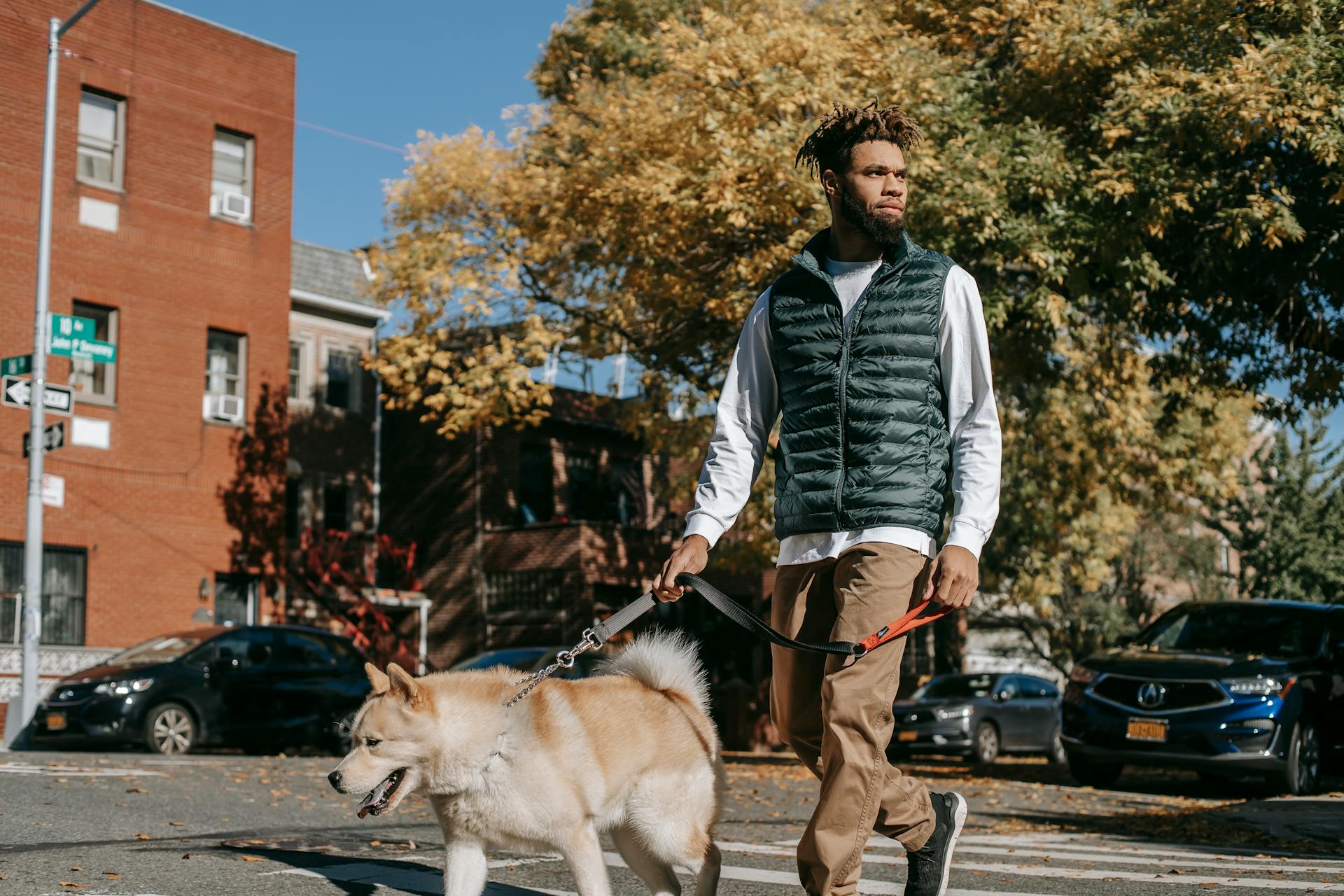
Bloat occurs when the stomach is distended with gas or air and then twists, impeding the normal return of blood to the heart. Symptoms include a distended abdomen, excessive salivating, and retching without vomiting.
Akitas can also be prone to hypothyroidism, a disorder of the thyroid gland, which can cause conditions such as epilepsy, hair loss, and obesity. This is treated with medication and diet.
Progressive retinal atrophy (PRA) is a family of eye diseases that involves the gradual deterioration of the retina, leading to night-blindness and eventually loss of sight. Many affected dogs adapt well to their limited or lost vision.
Sebaceous adenitis (SA) is a serious problem in Akitas, causing dry, scaly skin and hair loss on the head, neck, and back. This genetic condition is difficult to diagnose and often mistaken for other conditions.
Here are some common health issues to watch out for in American Akitas:
- Hip dysplasia
- Bloat
- Hypothyroidism
- Progressive retinal atrophy (PRA)
- Sebaceous adenitis (SA)
Nutrition and Feeding
Akitas require a diet rich in high-quality protein to maintain their robust physical structure, so aim for 1 gram of protein per pound of their American Akita weight.
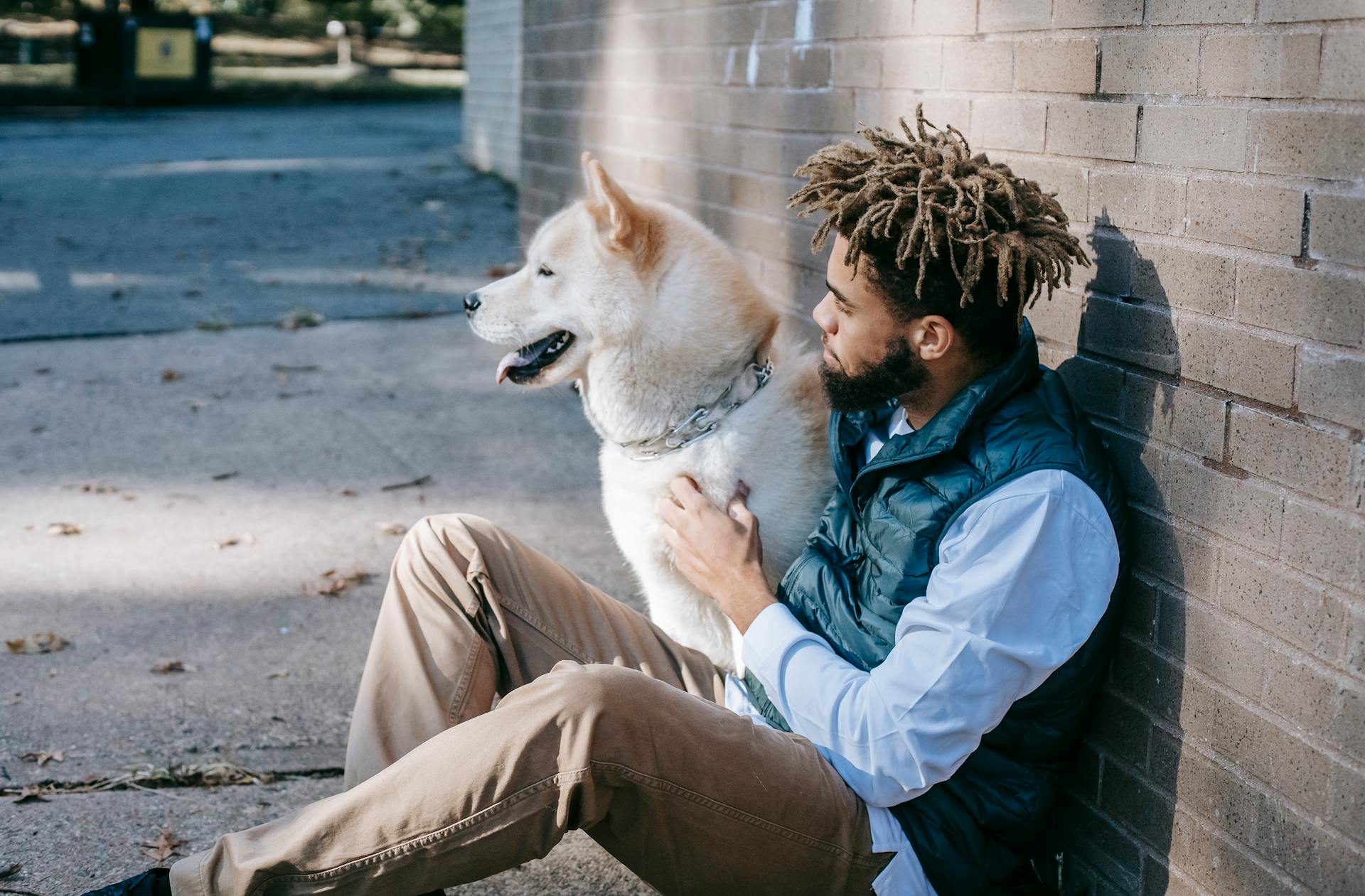
Feeding your Akita will vary depending on their physical activity level, so be sure to ask for regular weigh-ins at the vet to determine the right amount of food.
For Akita puppies, you'll need to adjust their feeding regime monthly to match their growth, starting with a smaller amount split into more feedings throughout the day.
Feeding your pup up to four times a day can support their metabolism, energy levels, and development. Here are some feeding suggestions for your growing puppy:
As your puppy ages, you can lower the number of feedings from 3-4 to twice daily, and continue feeding them puppy food until they're at least one year old to reap the benefits of added nutrients.
A different take: American Akita Akita Puppy
Socialization and Training
Socialization is key when it comes to raising an American Akita puppy. You must socialize your Akita puppy from a very young age to help them grow into a more socialized dog.
Worth a look: Akita Inu Puppies
Introduce your puppy to other animals, children, and both friends and strangers to help them become more confident in new situations. This can be done by introducing them to your friends and other dogs one at a time in controlled environments.
Daily walks are a great time to socialize your Akita, especially with strangers. Practice patience and persistence when training your Akita, as they need to be trained with love and respect.
Positive reinforcement goes a long way with Akitas, so avoid reacting negatively during training or treating them harshly. They may lash out in return if they feel threatened or scared.
Take a look at this: Bully Dog Training
Practice Patience and Persistence
Socialization and training are crucial for Akitas, and patience and persistence are essential for obedience training. Patience is key when training an Akita, as they can be sensitive to negative reactions.
If you react negatively during training, your Akita may lash out in return. Positive reinforcement, on the other hand, goes a long way with Akitas.
Training with love and respect is vital for building a strong bond with your Akita. By doing so, you'll be well on your way to raising a well-behaved and loyal companion.
Early Socialization
Early socialization is key to raising a well-adjusted American Akita. You can start socializing your puppy as young as a few weeks old.
Introduce your puppy to your friends and other dogs one at a time in controlled environments. This will help them get used to new people and dogs without feeling overwhelmed. They may act out when meeting many dogs at once, so it's best to start with small groups.
Daily walks are a great time to socialize your Akita, especially with strangers. This will help them become more accepting of new people and experiences. Early socialization is crucial for this breed to ensure they grow into well-adjusted adults.
By exposing your Akita to a variety of people, places, and situations from a young age, they can learn to navigate social interactions more gracefully. This will make them more adaptable and accepting of new experiences.
It's essential to supervise interactions between your Akita and children, especially if they're young. American Akitas can be loyal guardians and playmates, but they can also become a liability if not treated with respect and kindness.
Check this out: American Foxhound Puppy
Choosing a Dog
If you're considering bringing a new furry friend into your family, it's essential to choose a breed that's right for you.
Research suggests that smaller dogs, like the Chihuahua, require less space and exercise than larger breeds.
Some breeds, such as the Basset Hound, are more prone to drooling, so be prepared for slobbery kisses.
Dogs with high energy levels, like the Border Collie, need plenty of physical and mental stimulation to prevent boredom and destructive behavior.
Consider your lifestyle and living situation before bringing home a dog that requires extensive exercise, like the Greyhound.
Rescue Groups
If you're considering adopting an Akita, rescue groups can be a great place to start your search. Many of these organizations have a wide range of dogs available for adoption.
If you're located in California, you might want to check out Namaste American Akita, which is based in the state. Big East Akita Rescue serves New York, New Jersey, and Pennsylvania, making it a good option for those in the Northeast.
For those in the Midwest, the Midwest Akita Rescue Society is a great resource, covering Illinois, Indiana, Iowa, Michigan, Minnesota, Missouri, Ohio, Wisconsin, and parts of Kansas and Kentucky. TikiHut Akita Rescue Association is another option for those in Northern California.
If you're on the East Coast, Rakki-Inu Akita Rescue serves North and South Carolina and Virginia, making it a good choice for those in the region.
Here are some rescue groups to consider:
- Namaste American Akita (California)
- Big East Akita Rescue (New York, New Jersey, Pennsylvania)
- TikiHut Akita Rescue Association (Northern California)
- Midwest Akita Rescue Society (Illinois, Indiana, Iowa, Michigan, Minnesota, Missouri, Ohio, Wisconsin, Kansas, Kentucky)
- Rakki-Inu Akita Rescue (North and South Carolina, Virginia)
Temperament and Behavior
The American Akita is renowned for its loyalty, protection, and affection, embodying a complex temperament that is both dignified and fearless.
This breed forms deep connections with family, embodying a devoted and protective nature. Akitas are known to be thinkers and decision-makers, showcasing a degree of self-determination.
Despite their imposing presence, Akitas surprise with their sweet and affectionate side, often seeking companionship and following their loved ones closely. They are intelligent and adaptable, learning quickly but may display stubbornness, necessitating patient and consistent training.
Akitas are territorial, protective, and fearless, making them excellent watchdogs. They're also widely known for being suspicious of strangers.
They're not a very talkative dog breed, but when they do vocalize, their bark can be a murmur or moan, warning their owners of potential threats. Akitas can be trained to be more well-disciplined around strangers with proper training.
As Akitas are less tolerant of strangers, it's wise to be present when they meet guests. They're also sensitive to how they're treated, reflecting their behavior in response to their owners' actions.
Akitas are often possessive and jealous dogs, requiring proper training to manage their behavior around other pets. They may be selfish with their food bowl, toys, and even their owners' attention.
Akita puppies are courageous, intelligent, and loving, making them great companions for families. They love to cuddle and are happy to spend time with their owners wherever they go.
Akitas are known for their dignified and reserved nature, but they're incredibly affectionate with their families, showcasing a gentler side to those they trust. Their loyalty is legendary, forming a deep, unbreakable bond with their owners.
The American Akita is a bold, alert, and headstrong dog, tending to be more aggressive towards other dogs, especially those of the same sex. It's usually recommended that Akitas live in single-dog households.
This breed responds well to training when engaged properly, thanks to its superior intelligence and impressive capacity to learn. However, Akitas possess a strong-willed nature, requiring a nuanced approach to training that respects their independence and intelligence.
The Living Environment
The American Akita is a large and powerful dog that thrives in cold climates, originating from the snowy mountains of Japan. They have a thick double coat that protects them from harsh weather conditions.
They require regular grooming to prevent matting and tangling of their fur. The American Akita's thick coat sheds heavily, especially during shedding season.
Their large size means they need plenty of space to move around and exercise, making them a great fit for families with large yards. They are also naturally protective of their family and territory.
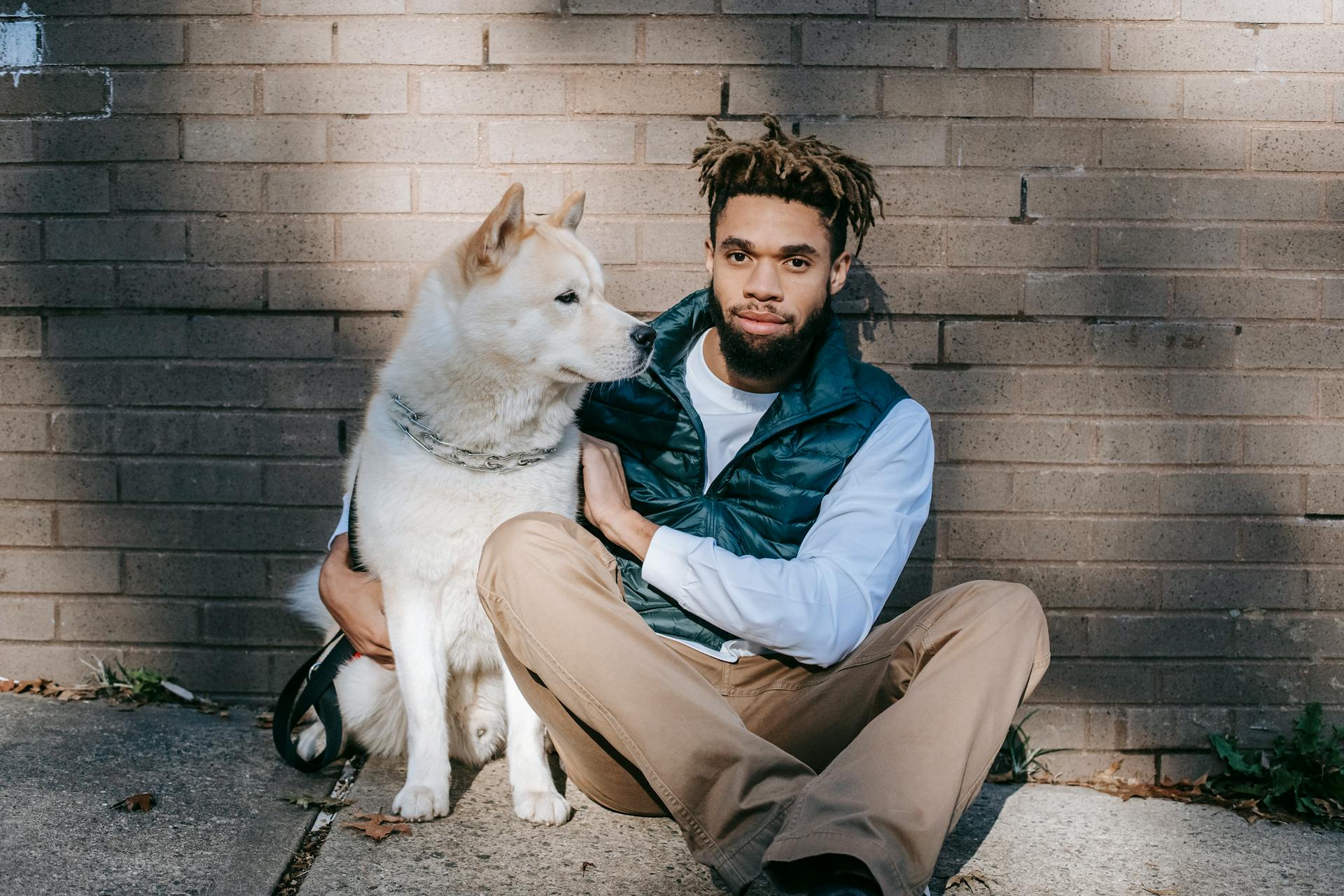
American Akitas are generally quiet dogs, but they will bark to alert their owners to potential threats. They are not typically suited for apartment living due to their size and exercise needs.
Their calm and gentle nature makes them a great fit for families with children, but they can be wary of strangers. Early socialization is key to helping them become confident and friendly dogs.
Ownership and Costs
Owning an American Akita can be a significant investment, with the initial cost of acquiring a purebred Akita ranging from $1,000 to $2,500.
Their thick double coat requires regular brushing, which can be a time-consuming task, especially for those with busy schedules.
The cost of owning an American Akita goes beyond the initial purchase price, with annual expenses amounting to approximately $1,000.
Their high-quality food and veterinary care needs can be substantial, making it essential to factor these costs into your budget.
Regular grooming, including occasional professional grooming, is also necessary to prevent matting and tangling of their coat.
The cost of an American Akita puppy can vary significantly based on several factors, including the breeder's reputation and lineage.
Worth a look: American Eskimo Grooming
Frequently Asked Questions
What are the disadvantages of American Akitas?
American Akitas can be high-maintenance pets, prone to shedding, requiring constant entertainment, and potentially developing health issues. They also have a strong prey drive and may exhibit aggression or wariness around strangers, making them less suitable for first-time owners.
Which is more aggressive Japanese or American Akita?
Neither the Japanese nor American Akita is inherently more aggressive, but they can both exhibit dog aggression. However, Japanese Akitas tend to be more wary of strangers and temperamental.
What is the difference between Japanese Akitas and American Akitas?
Japanese Akitas tend to be more slender with a fox-like appearance, while American Akitas are generally larger and more muscular. This physical difference is just one of the key distinctions between these two breeds.
Featured Images: pexels.com
